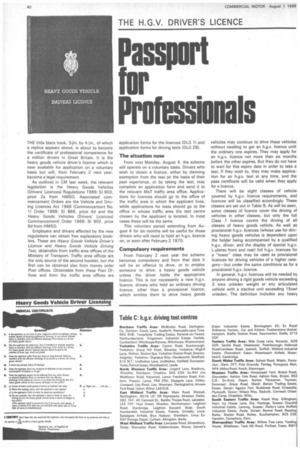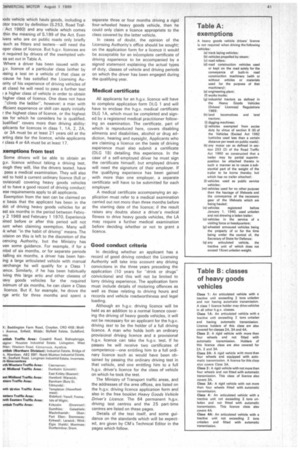Passport for Professionals
Page 42

Page 43

If you've noticed an error in this article please click here to report it so we can fix it.
THE little black book, 31in. by 44in., of which a replica appears above, is about to become the certificate of professional competence for a million drivers in Great Britain. It is the heavy goods vehicle driver's licence which is now available for application on a voluntary basis but will, from February 2 next year, become a legal requirement.
As outlined in CM last week, the relevant legislation is the Heavy Goods Vehicles (Drivers' Licences) Regulations 1969: SI 903, price 26 from HMSO. Associated commencement Orders are the Vehicle and Driving Licences Act 1969 (Commencement No. 1) Order 1969: SI 866, price 4d and the Heavy Goods Vehicles (Drivers' Licences) Commencement) Order 1969: SI 902, price 6d from HMSO.
Employers and drivers affected by the new regulations can obtain free explanatory booklets. These are Heavy Goods Vehicle Driver's Licence and Heavy Goods Vehicle Driving Test, obtainable from traffic area offices of the Ministry of Transport. Traffic area offices are the only source of the second booklet, but the first can be obtained also from money order Post offices. Obtainable from these Post Offices and from the traffic area offices are application forms for the licences (DLG 1) and application forms for driving tests (DLG 26).
The situation now
From next Monday, August 4, the scheme will operate on a voluntary basis. Drivers who wish to obtain a licence, either by claiming exemption from the test on the basis of their past experience, or by taking the test, may complete an application form and send it to the relevant MoT traffic area office. Applications for licences should go to the office of the traffic area in which the applicant lives, while applications for tests should go to the office in whose traffic area the test centre chosen by the applicant is located. In most cases these will be the same.
This voluntary period extending from August 4 for six months will be useful for those drivers who will need to hold an h.g.v. licence on, or soon after February 2 1970.
Compulsory requirements
From February 2 next year the scheme becomes compulsory and from that date it will be an offence to drive, or to employ someone to drive, a heavy goods vehicle unless the driver holds the appropriate licence. This is not necessarily a new h.g.v. licence; drivers who hold an ordinary driving licence, other than a provisional licence, which entitles them to drive heavy goods vehicles may continue to drive these vehicles without needing to get an h.g.v. licence until the ordinary one expires. They may apply for an h.g.v. licence not more than six months before the other expires. But they do not have to wait for this expiry date in order to take a test. If they wish to, they may make application for an h.g.v. test at any time, and the pass certificate will be valid when they apply for a licence.
There will be eight classes of vehicle covered by h.g.v. licence requirements, and licences will be classified accordingly. These classes are set out in Table B. As will be seen, some classes of licence cover the driving of vehicles in other classes, but only the full Class 1 licence covers the driving of all classes of heavy goods vehicle. As well as provisional h.g.v. licences (whose use for driving heavy goods vehicles is dependent upon the holder being accompanied by a qualified h.g.v. driver, and the display of special h.g.v. L-plates front and rear) full h.g.v. licences for a ''lower" class may be used as provisional licences for driving vehicles of a higher category—but under the same conditions as for a provisional h.g.v. licence.
In general, h.g.v. licences will be needed by anyone driving a rigid goods vehicle exceeding 3 tons unladen weight or any articulated vehicle with a tractive unit exceeding 15cw1 unladen. The definition includes any heavy iads vehicle which hauls goods, including a ator tractor by definition (S.253, Road Traf: Act 1960) and any vehicle which comes thin the meaning of S.199 of the Act. Even ivers who are on public roads only briefly such as fitters and testerswill need the oper class of licence. But h.g.v. licences are it required by drivers of the exempted vehes set out in Table A.
Where a driver has been issued with an g.v. licence of a particular class (either by Issing a test on a vehicle of that class or !cause he has satisfied the Licensing Auority of his experience of driving vehicles of at class) he will need to pass a further test a higher class of vehicle in order to obtain higher class of licence. One does not have "climb the ladder", however; a man with fficient experience or skill can apply initially r the highest class of licence, or the highest ass for which he considers he is qualified. lualifiecl" covers more than driving ability: iplicants for licences in class 1, 1A, 2, 2A, or 3A must be at least 21 years old at the arting date for the licence, while applicants r class 4 or 4A must be at least 17.
xemptions from test
Some drivers will be able to obtain an g.v. licence without taking a driving test, ough they will, like the drivers tested, have pass a medical examination. They will also ied to hold a current ordinary licence (full or ovisional) covering heavy goods vehicles id to have a good record of driving conduct; ese requirements apply to all applicants. Exemption from the test can be claimed on e basis that the applicant has been in the ibit of driving heavy goods vehicles for at ast six months in the period between Februy 2 1969 and February 1 1970. Experience lined before or after this period will not writ when claiming exemption. Many will ;k what "in the habit of driving" means. The icision on this is left to the discretion of the cencing Authority, but the Ministry has ven some guidance. For example, if for a ?hod of six months, or for separate periods telling six months, a driver has been haning a large articulated vehicle with manual iarchange he will qualify for a Class 1 :ence. Similarly, if he has been habitually iving this large artic and other classes of iavy goods vehicles for the required inimum of six months, he can claim a Class licence. But if, for example, he drove the rge artic for three months and spent a separate three or four months driving a rigid four-wheeled heavy goods vehicle, then he could only claim a licence appropriate to the class covered by the latter vehicle.
In cases of doubt, the opinion of the Licensing Authority's office should be sought; on the application form for a licence it would be acceptable for an inComplete certificate of driving experience to he accompanied by a signed statement explaining the actual types of duty, classes of vehicle and driving periods on which the driver has been engaged during the qualifying year.
Medical certificate
All applicants for an h.g.v. licence will have to complete application form DLG 1 and will have to enclose the h.g.v. medical certificate DLG 1A, which must be completed and signed by a registered medical practitioner following an examination. The certificate, part of which is reproduced here, covers disabling ailments and disabilities, alcohol or drug addiction, hearing and eyesight, Applicants who are claiming a licence on the basis of driving experience must also submit a certificate (DLG 1B) detailing this experience. In the case of a self-employed driver he must sign the certificate himself, but employed drivers will need the signature of their employer. If the qualifying experience has been gained with more than one employer, a separate certificate will have to be submitted for each employer.
A medical certificate accompanying an application must refer to a medical examination carried out not more than three months before the starting date of the licence; if the result raises any doubts about a driver's medical fitness to drive heavy goods vehicles, the LA may require a further medical examination before deciding Whether or not to grant a licence.
Good conduct criteria
In deciding whether an applicant has a record of good driving conduct the Licensing Authority will take into account any driving convictions in the three years preceding the application (10 years for "drink or drugs" convictions) and this will not be limited to lorry driving experience. The application form must include details of motoring offences as well as those relating to driving hours and records and vehicle roadworthiness and legal loading.
Although an h.g.v. driving licence will he held as an addition to a normal licence covering the driving of heavy goods vehicles, it will not be necessary for an applicant for the h.g.v. driving test to be the holder of a full driving licence. A man who holds both an ordinary provisidnal driving licence and a provisional h.g.v. licence can take the h.g.v. test. If he passes he will receive two certificates of competence—one entitling him to a full ordinary licence such as would have been obtained by passing the ordinary driving test in that vehicle, and one entitling him to a full h.g.v. driver's licence for the class of vehicle on which he took the test.
The Ministry of Transport traffic areas, and the addresses of the area offices, are listed on the h.g.v. driving licence application form and also in the free booklet Heavy Goods Vehicle Driver's Licence. The 64 permanent h.g.v. driving test centres and the 25 part-time centres are listed on these pages.
Details of the test itself, and some guidance on the standards which will be expected, are given by CM's Technical Editor in the pages which follow.


































































































